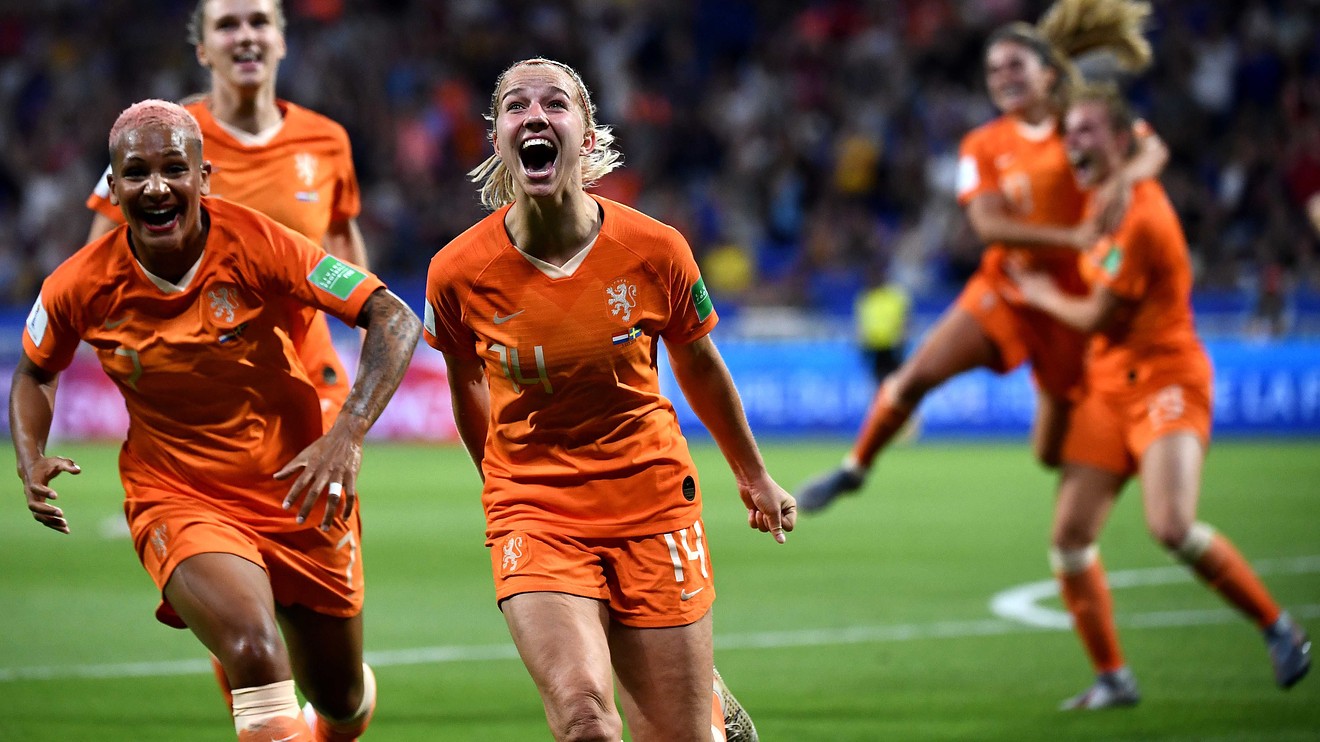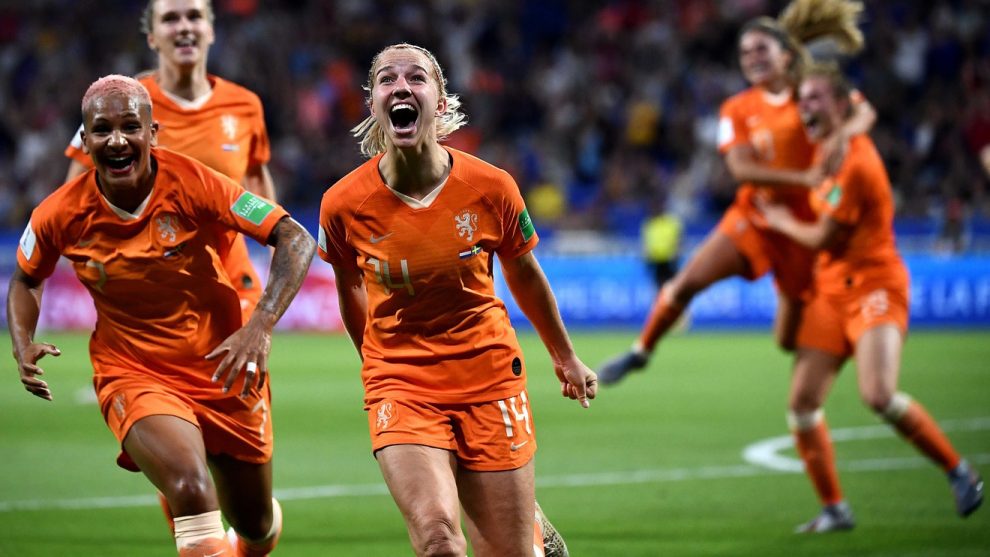
When the U.S. faced England on the football pitch earlier this week, the outcome was perhaps unsurprising: The U.S. was on its way to the women’s World Cup finals — and the English on their way home
What was arguably more stunning, however, was the reaction to star U.S. striker Alex Morgan’s tea-drinking pantomime in celebrating the go-ahead goal in American’s 2-1 victory against England.
Some English fans viewed this sip-heard-around-the-world as distasteful, while others were merely shocked at the display of arrogance on the game’s grandest stage. Many U.S. fans lauded the move as brilliant, though, and the New York Post immortalized the pinkie-out gesture on its front page.
Now the mighty U.S. women’s soccer team is set for an 11 a.m. Eastern time appointment (5 p.m. locally in Lyon, France) on Sunday with the Netherlands’ women’s side, and with that comes the opportunity for Morgan and her teammates to poke fun at a new opponent — as well as for the Orange Lionesses to get their jabs in at the American side.
Presumably, the U.S. mockery strategy would be to take something the Dutch hold dear — as Morgan arguably did with the tea sip vs. England — and turn it against the small and peaceful nation. But to avoid an international incident in a skittish world, here’s a field guide to how celebratory ribbing may translate if American players opt to mock the world’s fifth happiest country.
Don’t miss: Nike’s stock could be the big FIFA Women’s World Cup winner
Once upon a time, an obvious hand gesture taking aim at a uniquely Dutch characteristic may have involved pretending to smoke a joint. But that was before the U.S. became a world haven for legal marijuana. So this approach probably lacks oomph and might feel a tad outdated.
One reliable option, however, might be to confront the Dutch with their status as “cheese heads.” Holland produces some 1.4 billion pounds of cheese a year, according to NBTC Holland Marketing, with two-thirds of that exported globally, making the nation, with a mere 17 million population, the biggest cheese exporter in world.
Perhaps the best prop for taking aim at the fromage superpower would then be to don a foam Gouda hat after scoring a goal. However, that may lead to some confusion among U.S. fans from cheese-loving Wisconsin, who have long since adopted the cheesehead moniker but have some difficulty distinguishing between Swiss cheese and orange cheddar yet who are, nonetheless, nearly as adept at cheese consumption as Holland.
Artistic references could work, perhaps via a chiding of the Dutch masters.
Referencing Vincent van Gogh, five U.S. players could quickly assemble to mimic eating dinner at a farm table in imitation of “The Potato Eaters.”
An even more elaborate reference to Rembrandt van Rijn’s masterpiece “Night Watch” would take the full U.S. team, plus at least nine U.S. players on the sideline, to re-create the 17th-century painter’s seminal display of the chiaroscuro style. It would be a sight to behold.
A Johannes Vermeer reference also would be apt, and his “Girl with a Pearl Earring” would allow for a single-player re-enactment.
American-Dutch shared heritage seems fair game. The first U.S. president not born under rule of the British Empire was Dutch speaker Martin Van Buren, who was nicknamed “the little magician” and, alternately, “the little fox” (before failing in his bid for a second term), which opens up a plethora of options for U.S. players to deliver a pantomime of prestidigitation.
When in doubt, however, go to the numbers: The U.S. boasts more people who play soccer at some level than there are people in the Netherlands — 24 million, according to FIFA data as of 2007. That’s roughly 7 million more people than the entire Dutch population. It would take the fingers of just three soccer players to make the number 24. That would sting.
Pretending to eat a stroopwafel would have been a perfect way to nod to the Dutch, but Starbucks SBUX, +0.00% now sells such caramel wafels, they’ve become a common in-flight giveaway, and even McDonald’s MCD, -0.74% is currently offering the Stroopwafel McFlurry.
In a pinch, there is always fake news. During the Winter Olympics, one American commentator said the Dutch consider ice skating an important mode of transportation. Pretending to skate would be easy, effectively deploying a basic aerobic move. The Dutch don’t, in fact, skate to work, but who cares these days?
If you do persist in caring about facts, many Dutch ride bicycles to work, so a last resort could be for a U.S. soccer player to execute a celebratory bicycle kick.
For Holland’s part, it remains to be seen what gestures or other symbolic acts would make the cut. The easiest target may be for the Dutch to target Americans’ notorious lack of fluency in anything but English, while the Dutch team can typically speak four or five languages. The Lionesses also could point to the U.S.’s status as only the 19th happiest country, perhaps by showing a sad face, or employing two players’ fingers to make the number 19.
Dutch fans are also known to be creative with their chants.
Of late, many have been singing Monty Python member Eric Idle’s “Always Look on the Bright Side of Life” when crushing foreign opponents, as did AFC Ajax fans recently. They are probably perusing the U.S. music catalog right now for material. Would “What a Wonderful World” as popularized by Louis Armstrong work? Could Don McLean’s epic “American Pie” or Bruce Springsteen’s somewhat ironic “Born in the U.S.A.,” or even “Shake It Off” by Taylor Swift soon be heard by Dutch fans?
Perhaps “thank u, next” by Ariana Grande?
We shall see or hear, shortly — should the oddsmaker underdog Dutch score, that is. Americans probably don’t want to contemplate that possibility at this time.
Whichever gestures make their debut, Sunday’s game should be a good one. May the best team win. And celebrate.









